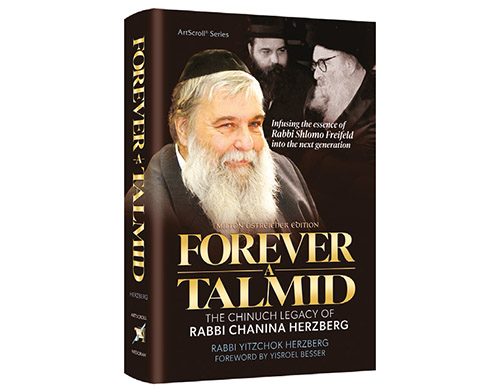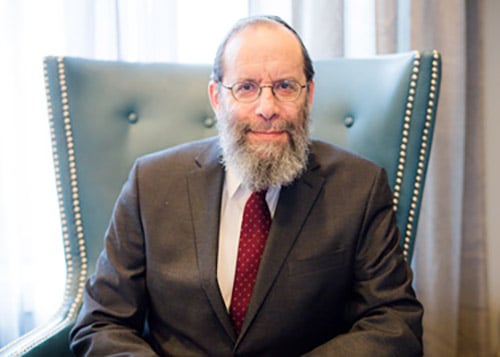
Highlighting: “Forever a Talmid: The Chinuch Legacy of Rabbi Chanina Herzberg” by Rabbi Yitzchok Herzberg. Artscroll Mesorah Publications. 2023. Hardcover. 372 pages. ISBN-13: 9781422632833
(Courtesy of Artscroll) “Forever a Talmid” tells the story of mesorah reverently handed down generation to generation. The story of the timeless rebbi-talmid bond. The story of greatness in the yeshiva, the classroom and the home—and the story of the power of one man’s warmth, determination and belief in every Jew.
Charlie Herzberg was a regular American boy. Fantastic third baseman, popular with his classmates, not a top student. But there were Torah scholars and leaders who saw a spark of greatness in young Charlie. Who believed in him, and helped him believe in himself. And so he grew up to become Rabbi Chanina Herzberg, the master mechanech who always believed in his talmidim and who always, always, remained a talmid of his own rebbi, Rav Shlomo Freifeld.
A talmid muvhak of Rav Freifeld, Rabbi Herzberg was the recipient of a glorious mesorah—from the Alter of Slabodka to Rav Yitzchok Hutner to Rav Freifeld, whom he consulted on a daily regular basis. He brought that mesorah of gadlus ha’adam, the greatness of man, into every aspect of his life. As menahel of Yeshiva Toras Chaim at South Shore for decades, Rabbi Herzberg had a vision of what a yeshiva should be: a place where every child “connects to the Ribono Shel Olam, and learns to be a mentch.” He took care of everyone—rebbeim, moros, teachers, parents and, of course, talmidim—bringing out the best in them, because he truly saw what was best in them.
In “Forever a Talmid” we will read story after story about Rabbi Herzberg, Rav Freifeld, and the others who were so central to his life. We will learn how much work it takes to be a true talmid, and the enormous, uncountable benefits. And how a few words spoken at the right time can change a person’s life. And how if we believe in a child or talmid—indeed, in any person—he will learn to believe in himself.
And, yes, we will learn how to believe in ourselves as well.
The following are several choice anecdotes from this uplifting book.
Where Will These Sneakers Take Me?
One day during dismissal at Yeshiva Toras Chaim, a bunch of boys were standing together when Yechiel*, a boy from a well-to-do family who was beginning to display bullying tendencies, noticed that Shaya*, who came from a poor family, was wearing cheap sneakers. In front of the crowd, Yechiel shouted disparagingly, “Hey, look at the sneakers you’re wearing, from Payless! I’m wearing Nikes!”
Shaya was broken and didn’t know what to respond. Little did he know that his savior was in earshot. At that moment, R’ Chanina happened to be passing by and heard the comment.
“Everyone here shops at Payless!” he belted out.
R’ Chanina proceeded to give an impromptu mussar shmuess. “Boys, you’re going to learn in time that the sneakers you wear make no difference. It’s where you will walk and talk in those sneakers that will make a difference. It’s about what’s on the inside that counts. It’s not about the money you have, it’s about what you do with it. As you grow older, you’re going to ask yourselves: Where did these sneakers take me?”
Just warming up, R’ Chanina gave Yechiel an assignment. “Tomorrow, come back and tell me what you are going to achieve in life with these sneakers. What great things are you going to accomplish with everything you have?”
Yoni* witnessed the scene and related that at that moment R’ Chanina was successful on two fronts: lifting Shaya’s spirits and overturning Yechiel’s attitude regarding what’s important in life.
The Purpose of the Farher
As a talmid in Yeshiva Toras Chaim, Charlie was farhered several times by R’ Nissen Telushkin. Many years later, he recollected, “When I was a talmid in Yeshiva Toras Chaim, there were two types of farhers. One was given by a certain talmid chacham, who farhered the class to show each boy how much they should have known. After those farhers, I walked out feeling terrible, as I never did well. Then there was the ‘R’ Telushkin farher.’ He farhered to show you how much you knew. When I walked out of the ‘R’ Telushkin farher,’ I felt like a million dollars. When I farher a class,” R’ Chanina concluded, “I give the ‘R’ Telushkin farher.’”
R’ Scharhon related that when R’ Chanina would come to give his class a farher, he and R’ Chanina had a secret code: “R’ Telushkin.” If R’ Scharhon noticed that a particular talmid, who generally didn’t know the material that well, was able to answer a specific question that R’ Chanina had just posed, R’ Scharhon would interject, “‘R’ Telushkin,’ you didn’t call on this boy yet,” or “‘R’ Telushkin,’ I think this boy has an answer to this question.” After hearing the code, R’ Chanina would call on the boy and praise him to the sky when he got the answer right. And if there was still a boy who hadn’t done well on the farher, R’ Chanina would ask R’ Scharhon to send the boy to R’ Chanina’s office, so the talmid could say a piece of Gemara that he knew well and receive his share of praise.
As R’ Chanina saw it, the purpose of a bechinah is to show the talmid how much he knows and how good he is, to demonstrate to him what he can be and what he can do. It is not for the rebbi to see how much the talmid knows; he should already know how his talmidim are faring without the bechinah.
The sefer Maaseh Ish (Vol. 7, p. 61) describes a farher given by the Chazon Ish. “We received many farhers from the Chazon Ish,” recalled a talmid who grew up in Bnei Brak, “and each time we were certain that he did everything he could to make each boy feel good about how he did on the bechinah, that the boy would experience seva ratzon and walk away with a renewed cheishek to continue learning.”
That was the purpose of the Chazon Ish’s farher.
And R’ Telushkin’s.
And R’ Chanina’s.
Sharing a Yarmulke … and Yiddishkeit
Ruvy* grew up in a frum home and attended yeshiva. Unfortunately, as a teenager he strayed from the proper path. One Shabbos, Ruvy, now a young adult, stayed with a friend. Though it had been some time since he had last attended shul, he went with his friend to R’ Chanina’s shul. However, he didn’t bother wearing a yarmulke.
As Ruvy entered the shul during Mussaf, R’ Chanina took note of the newcomer and motioned to him to sit next to him at the front of the shul. R’ Chanina, who was wearing a hat, removed his yarmulke from under his hat, gave it to Ruvy, and placed his arm around him. R’ Chanina remained at Ruvy’s side during the Kiddush, as well, making him feel welcome and comfortable. No lengthy conversation, just wise eyes and true love for another Jew.
That was a turning point in Ruvy’s return to Torah observance. R’ Chanina’s warm and selfless act touched his neshamah, helping catalyze a complete turnaround. He began to wear a yarmulke more often, always the yarmulke R’ Chanina had given him, which he so cherished.
Today, Ruvy is a fully-observant Jew.
Soldiering On
It wasn’t always easy to keep building up the boys, to keep up the positive atmosphere, especially at the end of his life. Yet to R’ Chanina, this was a number-one priority. While undergoing treatment for cancer, R’ Chanina’s hair started to fall out, and he was told that within several weeks he would lose his beard.
R’ Chanina was distraught. Though he wanted so badly to be in yeshiva, to him, being around talmidim without a beard wasn’t an option, for two reasons: First, he was concerned that since most of the children weren’t capable of understanding the circumstances, they would be scared and uncomfortable. Second, his life’s mission was to build up talmidim, to create a ruach in the yeshiva of positivity and warmth. Being there without a beard would create a negative, unsettling atmosphere and would constitute a contradiction to what he was trying to accomplish. If he couldn’t do what he was supposed to do, it would be better for him not to be there at all.
Knowing how much this meant to her husband, Mrs. Herzberg researched fake beards used in professional plays and theaters and ordered them. Every morning, she would paste a beard on her husband’s face using a special glue and each evening she would take it off. Besides being a very time-consuming process, a few hours each day, it was also a very painful one. At times, R’ Chanina would cry out in pain from the tugging and plucking and stickiness on his delicate skin.
But R’ and Mrs. Herzberg soldiered on. The two of them would awaken every morning at around 4:00 a.m. and begin the process, so R’ Chanina could be ready to go to yeshiva by 7:00. There was nothing R’ Chanina and his extraordinarily dedicated wife wouldn’t do or go through for his talmidim.
Show, Not Tell
“The foundation of good chinuch,” stated R’ Chanina, “is the personal example parents set for their children. This idea is repeated over and over in the sefarim of ‘big Jews,’ and I have personally witnessed this myself. You want your children to be baalei chesed and sensitive Jews, you need to be the paradigm of gemilus chasadim. You want them to have middos tovos, you need to have middos tovos. If a father and mother are committed to developing their own character traits, then the children, by osmosis, absorb their behavior into their own personalities.
“Numerous times over the last 40 years, I have seen children of ‘regular, simple Jews’ who became the heads of beautiful families, vibrant members of communities, and fine, outstanding ambassadors of our nation. It was not because their parents forced them to learn or daven. Rather, it was their own humble approach to avodas Hashem, and their constant, subliminal message that they provided for their children. A message of middos, chesed, ahavas Yisrael, ahavas Torah, and concern for what was important. We must set good examples for our children. If we do, we stand a very good chance of having doros yesharim mevorach, blessed generations following the straightforward way of the Torah.”
Though R’ Chanina believed in this method of chinuch habanim from the moment he had his first child, it took time until he managed to master the methodology and make it a part of him. And it was R’ Shlomo who helped him get there, all but knocking it into him. One Shabbos morning, soon after R’ Chanina had been hired as menahel of Yeshiva Toras Chaim, he was davening in Yeshiva Sh’or Yoshuv with his eldest son. He was trying to coerce his son, all of 9 years old, to daven Shacharis. After all, how would it look if the menahel’s own son is not davening?
After davening, R’ Shlomo summoned R’ Chanina for a quick “conference.”
“R’ Chanina, what were you doing to your son during davening?”
Slightly flustered, R’ Chanina replied, “I was trying to get him to daven.”
“No!” R’ Shlomo asserted. “Do not preach. Let him see that you take it seriously, that it’s real to you. Then he will daven.
“And one more thing,” R’ Shlomo added with his usual dose of humor, “if I ever see you poking your son again, trying to get him to daven, I’ll hit you over the head with a stick!”
That one incident helped formulate a path in chinuch that has impacted thousands of children. It was the catalyst to mastering the method of practicing, not preaching. For close to 40 years, R’ Chanina related this story to young parents who came to him for advice; it became his refrain: “Rabbosai, I’m telling you, if you want your children to do something, then make sure you are doing it yourself!” Those few words of advice helped numerous parents lay the proper framework for excellence in chinuch habanim.
R’ Chanina would often say, “Children learn more from looks than from books.” In many ways, parents and teachers teach more through action, by what the children see them doing, than through book-teaching.
The Rebbe-Talmid Bond












